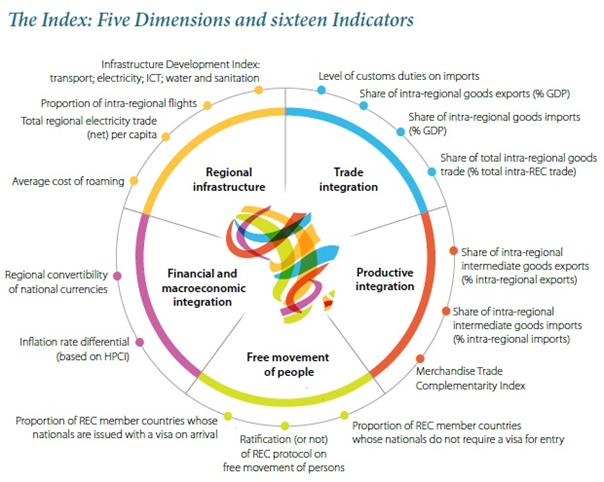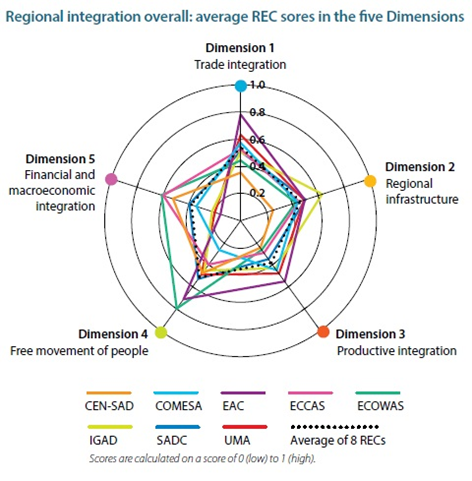Highlights – Africa Regional Integration Index Report 2016
Integration Matters
Regional integration is a development priority for Africa. All Africans, not just policy makers and decision makers, have a role to play in making integration a reality for the continent. Integration matters in Africa. It affects what people can buy; the variety of what is on offer at the local market; how easily citizens move between countries; where individuals travel for leisure or for work; how cost-effective it is to keep in touch; where people choose to study or look for a job; how to transfer money to family or get start-up capital for a business. Regional integration is about getting things moving freely across the whole of Africa. This means getting goods to move more easily across borders; transport, energy and telecommunications to connect more people across more boundaries; people to move more freely across frontiers, and capital and production to move and grow beyond national limits. Africa’s integration journey towards a more connected, competitive and business-friendly continent is underway and its roadmap is, in some areas, under construction. Africa’s Regional Integration Index is an action tool measuring the progress of an Africa on the move.
Index Makeup
The Index is made up of five Dimensions, which are the key socio-economic categories that are fundamental to Africa’s integration. Sixteen Indicators (based on available data), which cut across the five Dimensions, have been used to calculate the Index. The Index 2016 report covers Member Countries from the eight Regional Economic Communities (RECs) recognized by the African Union. The Dimensions and Indicators chosen for the Index are based on the Abuja Treaty and its operational framework.
Regional integration is cross-border and multi-dimensional. Where data is available for some African countries but not all for a given indicator, this should not pose problems for the index. The indicator in question can still be included and this will not distort the overall scores for countries for which there is missing data. Future editions of the Index will grow in scope as more data becomes available.

Index Impacts
The Index aims to be an accessible, comprehensive, practical and results-focused regional integration tool that focuses on the policy level and on-the-ground realities.
RECs can be compared on overall integration scores and on scores in each of the five Dimensions. As the Index recognizes and uses the RECs as the building blocks for the African Economic Community, based on the Abuja Treaty, there are no overall country rankings A country’s classification within a REC shows (with a 95 per cent confidence interval) when a country is a; high performer, average performer and low performer.
Status of Regional Integration in the RECs
Index ranking is in line with progress being made on RECs’ regional integration agendas. The RECs score highly on areas that they have prioritized in implementing regional integration programmes. The different RECs’ performance on the dimensions emphasises how progress is being made through a regional approach to integration in Africa rather than through a continent-wide approach.
Index Rankings

- Average REC scores on Regional integration stand at 0.470 on a scale of 0 (low) to 1 (high). Average regional integration scores for the eight RECs stand at below half of the scale from 0-1, showing that overall integration in the regions could significantly progress.
- EAC is the top performing REC on regional integration overall. EAC has higher than average scores across each Dimension of Regional integration, except for financial and macroeconomic integration.
- SADC and ECOWAS have higher than average REC scores on regional integration overall. SADC has higher than average REC scores across the Dimensions of Regional infrastructure, Free movement of people and Financial and macroeconomic integration. ECOWAS has higher than average REC scores across the Dimensions of Free movement of people and Financial and macroeconomic integration.
REC Scores in the five Dimensions
There is a strong basis for every REC to build on and address other Dimensions, which can strengthen the integration agenda and drive up a REC’s overall regional integration score. To further support integration policy reforms across the continent, the eight RECs can share lessons and insights on each of the Dimensions where they score higher than the average.

- Highest scores are on trade integration, with average REC scores of 0.540. Trade integration has been a longstanding regional integration priority across all RECs.
- Lowest scores are on financial and macroeconomic integration, with average REC scores of 0.381. Financial and macroeconomic integration has been limited across the RECs, including ensuring the convertibility of currencies or coordination of macroeconomic policies.
- Average REC scores are closest together on Regional infrastructure and Productive integration. Regional infrastructure and Productive integration have recognized REC programmes and progress is ongoing across the regions.
- Average REC scores are furthest apart on Free movement of people and Financial and macroeconomic integration. Free movement of people protocols have been signed but their application on the ground has faced challenges in different regions. Ensuring the convertibility of currencies and the coordination of macroeconomic policies at regional level has also not been consistent.
- Every REC has higher than average scores in one or more Dimensions.
Status of Regional Integration in Countries by RECs
Integration is multi-dimensional for both RECs and for the countries within each REC. The majority of countries perform well in at least one dimension of Regional integration, even if their overall regional integration score is not high. With the exception of Somalia in CEN-SAD and IGAD, there are no countries that are marked as low performers across all the dimensions. Each country can share lessons and insights with other countries on the areas where they perform strongly and also identify how to address any gaps going forward.
The following map portrays top countries on regional integration with ‘deep and broad’ integration scores. For further details, including the performance of individual countries, see Integate-Africa.org.

Source: Africa Regional Integration Index Report 2016 - AUC, AfDB, UNECA (2016)
For more information see: Integate-Africa.org.
Download: Africa Regional Integration Index Report 2016 - Author(s): AUC, AfDB, UNECA (File size: 1.13 MB) Methodology for Calculating the Africa Regional Index 2016 (File size: 1.03 MB)